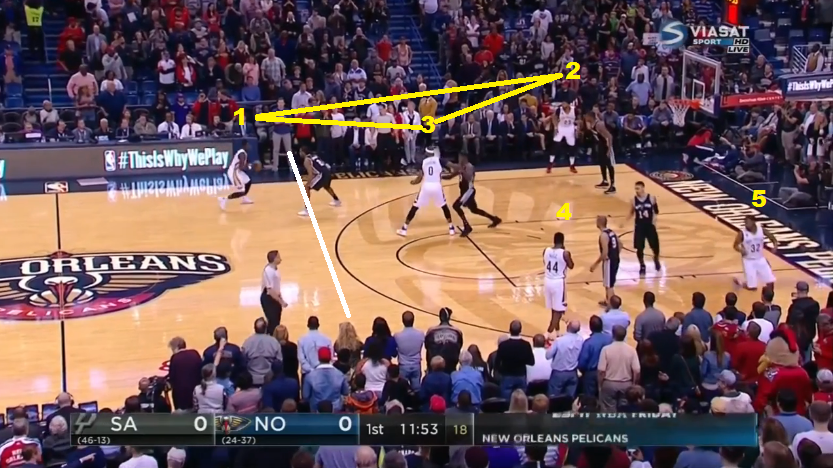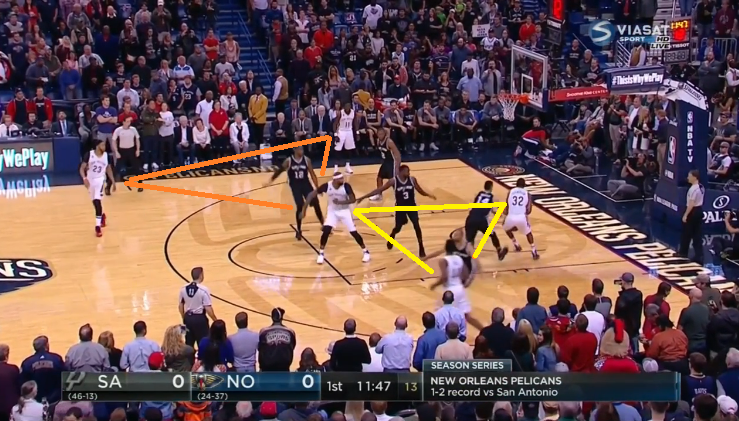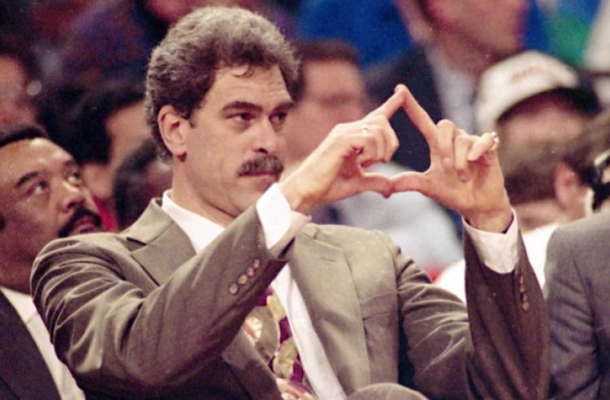Much has been made of the Pelicans struggle offensively this season. It was a doomed proposition to begin with as point guard Jrue Holiday was scheduled to miss a few weeks taking care of his family at home. However the Pelicans offense has not been remarkably better since his return. The Pelicans not only look lost in the half court over the course of the game, they are demonstrably disoriented coming out of timeouts and sideline out-of-bounds plays. With an ultra-efficient basketball demon named Anthony Davis, you’d figure drawing up plays out of a break would be easy. Yet the Pelicans consistently look out of position and out of sync. Players either go too early, too late, they don’t screen the proper guy, and frequently bump into each other. It’s a cacophonous traffic jam enabled by the lack of offensive threats that litter the Pelicans roster. This dearth of talent is perhaps best encapsulated by Anthony Davis’s monster stretch to start the season. While Davis was putting up 35+ points a night, the Pelicans were taking loss after loss. Many people criticized the Pelicans offense for devolving into dumping the ball to Davis on the elbow and everyone getting out-of-the-way. There is mild weakside action to keep the defense “occupied”, but it fools absolutely no one. Opponents are happy to see Solomon Hill chuck up brick after brick. Davis doesn’t carry the gifted playmaking of the likes of LeBron and Jrue Holiday didn’t provide enough of a relief. Leading up the all-star break, the Pelicans ranked 27th in offensive rating. Then came the Boogie trade.
To say it’s been a process incorporating Boogie is an understatement. Not only did the Pelicans add a historically high usage big man to compliment their other historically high usage big man, they replaced much of their wing depth with loose change and pocket lint. Hollis Thompson now finds himself the starting shooting guard of your New Orleans Pelicans. With limited practice and a completely overhauled roster, the Pelicans look more out of sorts than people expected. It’s drawn the Boogie detractors out of the shadows as people indignantly proclaim this is the DeMarcus Cousins effect. Yet both Davis and Cousins have been incredibly productive as individuals since taking the court together. Individuals is the key word. The Pelicans are held back by seemingly unsustainable poor shooting across the rest of the roster. Moore, Holiday, Hill, Thompson, and Frazier all sport putrid true shooting percentages below 47%. The Pelicans are shooting 21.8% on open threes and 30.8% on WIDE open threes – both are league lows. The luck is bound to turn. But pressure is mounting from fans, justified or not, that Alvin Gentry do something about the offense. Adjusting to this much change is not an easy task, but on Friday vs the Spurs, we saw a glimmer of offense that looked unstoppable for a stretch. If you squint really hard you’ll see that it derives from the ever polarizing framework called the Triangle.
Gasp. The Triangle? Yes, the very system that has seemingly become a meme and a constant source jokes regarding the Knicks (lol Knicks). We’ve all heard the criticisms – the triangle is arcane, difficult to learn, only successful with superstars the likes of Jordan and Kobe yadda yadda yadda. The Knicks haven’t done much either to instill confidence in the resurgence of the triangle either. Gone is Derek Fisher from the Big Apple, replaced by Jeff Hornacek. The Knicks have improved from 26th in offensive rating to 16th under Hornacek, yet in a time where the Rockets are hoisting up almost 50 threes per game, the copy-cat league is gravitating towards the pace and space motion systems that seem to be what all the cool kids are doing. The Triangle is looked at as a phase that you thought was cool in high school (pastel polos for me) but really you’d rather forget you ever partook in it.
On the surface, everything about the triangle is contrary to the direction the league is heading in now with the under reliance of a point guard and methodical half court play. Yet with two dominant bigs, the Pelicans themselves are running contrary to the small ball trend that has set the league on fire. But to understand how the Triangle might have merit for the Pelicans, first we have to understand some basic principles. Tex Winter, Phil Jackson’s brilliant sidekick, details 7 important tenets. We will focus on only a few.
- Spacing: Perhaps the most important aspect of any offense, the Triangle dictates there be 15-20 feet between each player at all times. This prevents the defense from effectively trapping any one player as there to too much ground to cover in recovery. As deprived as the Pelicans are on the wings, it’s extra important their players follow this principle to avoid getting in each other’s way and bringing defenders in unnecessary areas. This will generate open shots if AD and Boogie are doubled.
- Ball and player movement: Similar to a motion offense, the Triangle preaches a ton of player movement, especially off the ball. The ball moves around from player to player in search of open shots.
- Fill any spot: The difference between the Triangle and motion offense is the Triangle has players run to 5 specific spots on the floor while the motion offense has no such restriction. However, the Triangle allows for any player to occupy any of those 5 positions as they are seen as interchangeable. Obviously certain set-ups are more desirable due to mismatches, but looking that the Pelicans roster, it’s not difficult to see the wings exchanging spots with each other, or the bigs doing the same.
- Penetration of defense: No offense can function unless you can break down the defense. However, the Triangle doesn’t always depend on your traditional dribble penetration. Often a post entry to the high post or pinch post position serves as the starting point for penetrating the defense. This tenet suits the Pelicans particularly well as they are devoid of guards outside Jrue who are capable of dribble penetration. They are, however, replete with talented bigs for the post entry.
Friday night against the Spurs, the Pelicans ran options out of a sideline triangle 7 times in the first quarter. They ended up scoring on 6 out of 7 attempts and generating 13 points (would have been 14, but Boogie missed a free throw). Also 4 out of the 5 players on the floor put the ball through the hoop during this stretch. For a span of a quarter, the Pelicans looked unstoppable. And a quarter is precisely how long this action lasted, never to be seen for the rest of the game.
Let’s break down how the Pelicans are slowly incorporating aspects of the triangle into their current offense.
The Pelicans opened up the game with this sequence.
The play is initiated out of a sideline triangle framework as seen here.

Holiday initiates the play at the point of attack. Davis is in the strongside corner. Cousins occupies the high post while Hill and Thompson occupy the weakside wing and corners respectively. Traditionally the sideline triangle has a player in what is known as the “pinch post” opposite of Boogie as it is a mirror offense, however Pels need all the spacing they can work with and park Hill beyond the arc. But in a nutshell, there is usually a strong side triangle coupled with a weakside two-man game.
The Triangle encourages players to read and react to the defense. This read and react action is often triggered by what Phil Jackson dubs the “moment of truth”, which is highlighted by the white line above. The moment of truth is an imaginary line that the ball handler uses as a guide for his next action. As he approaches the imaginary line, he reads the defense for the best option. If the post entry is available, it is taken, as seen in the clip above. If not, often times there is a “lag pass” in which a trailing player is available as a release. Here Holiday passes the ball to Cousins for the post entry. Holiday makes what is known as a point guard inside cut, as he cuts between Davis and Cousins to the corner. Cousins begins the dribble entry and this triggers the weakside action after he see’s AD is not available as an option. Thompson and Hill interchange places and Thompson cuts towards the basket. Boogie potentially had a lob available here, but hits Thompson with a nifty bounce pass and Thompson is able to convert on the reverse. Notice how the triangle formation very much remains.

In their next trip up the court, the Pelicans came down in a sideline triangle once again.
However, this time Boogie initiates a high screen for Holiday who collapses the defense and generates a wide open shot.
For the third consecutive time, the Pelicans opt to set up in the same formation.
This time when Holiday reaches the moment of truth, he sees his defender, Kwahi, forcing him sideline. The post entry to Boogie is difficult around the Claw so Holiday initiates a dribble hand-off with Davis. Davis and Cousins have some improvised screen and roll action and Davis draws free throws after the San Antonio switch on defense. This is textbook read and react. Holiday read his options and opted to go for a more open Davis who in turn initiated a two-man game with Cousins.
After a couple of possessions, the Pelicans decide to flip Davis and Cousins.
This time Davis is in the high post while Cousins is in the corner. After the post entry to Davis, Holiday sets a down screen for Cousins. Here Cousins has an option – he can choose to go under Davis or over Davis. He fakes under and goes over, triggering a San Antonio switch. He receives the ball from Davis and gets a good look at the rim which he fails to convert. This modified variant of the triangle is one of Alvin Gentry’s pet plays called the “Elbow Cyclone”.
Usually a forward such as Grant Hill in involved in this action, so it’s quite impressive we see the 6’11”, 270lbs Cousins running it.
The next time we see this formation, Holiday initiates dribble entry and dumps off to Cousins at the top of the key.
Cousins has a favorable 1-on-1 matchup which he exploits for an AND-1. Again, reading and reacting.
The sixth time we see this set up, it’s similar to the 4th.
Holiday feeds Boogie in the post, and sets a screen for Davis. Here Davis takes the option to under Cousins. As Davis slightly bobbles the pass, the defense collapses on him and he is able to kick out to a wide open Thompson. Had the pass been a bit cleaner or the defense not reacted, Davis was looking at an easy layup at the rim. But he instead reacted to the shifting defense.
The final time we see the Pelicans use this set, Jrue Holiday calls his own number.
Like the previous occurrence, Holiday gets the ball to Boogie in the post. Davis goes too early this time and Holiday is unable to set a screen to free him. Holiday then circles back into high screen and roll action with Cousins. With Pau ICEing the pick and roll, Jrue has an open free throw line jumper which he buries.
In this short stretch of basketball, the Pelicans executed perhaps their best offense of the the season. They looked unstoppable against the best defense in the league, and it all stemmed from a basic sideline triangle. Now I doubt Alvin Gentry has gone full on Phil Jackson on us, but it is clear he is borrowing ideas from the Triangle to mold an offense around the new age twin towers. And why not?
The Lakers had lasting success with it, using variations that included Odom, Gasol, Bynum and Kobe. The Pelicans don’t have anything close to a Kobe on the team, but Holiday is more of a scoring guard than a pure facilitator. E’twuan Moore easily slides into the Derek Fisher role. Solomon Hill, if you take a couple shots of bourbon, can be Trevor Ariza. In any case, what we saw above was an extremely basic portion of the Triangle with limited weakside action. With upgraded wings this summer and a full training camp, Gentry should look to incorporate more aspects of the Triangle. In the meantime, we’ll have to settle for the little tidbits we see on a game to game basis. Who knows, maybe we’ll see a resurgence of the Triangle and the Pelicans will be on their way to 11 champ;ipnsikp[ ringhs.

2 responses to “Alvin Gentry’s Secret Sauce: A look at why the Pelicans should run the Triangle”
Wow, great article!!
Did you do like 8 shots of bourbon while writing the very end? Haha
With the ability of both Davis and Cousins to handle the ball, shoot and pass out of the post, I was thinking the Pels might want to run some version of the Princeton offense, like the Nets did with their conference championship teams in the early 2000s and the Kings did with Chris Webber. It allows guards and wings (who may not have elite ability to get their own shots) to back-cut and flare to the three point line in a constant motion offense. Some elements of the Triangle and Princeton offense overlap as detailed in this informative piece…https://www.quora.com/In-basketball-what-are-the-triangle-and-Princeton-offenses